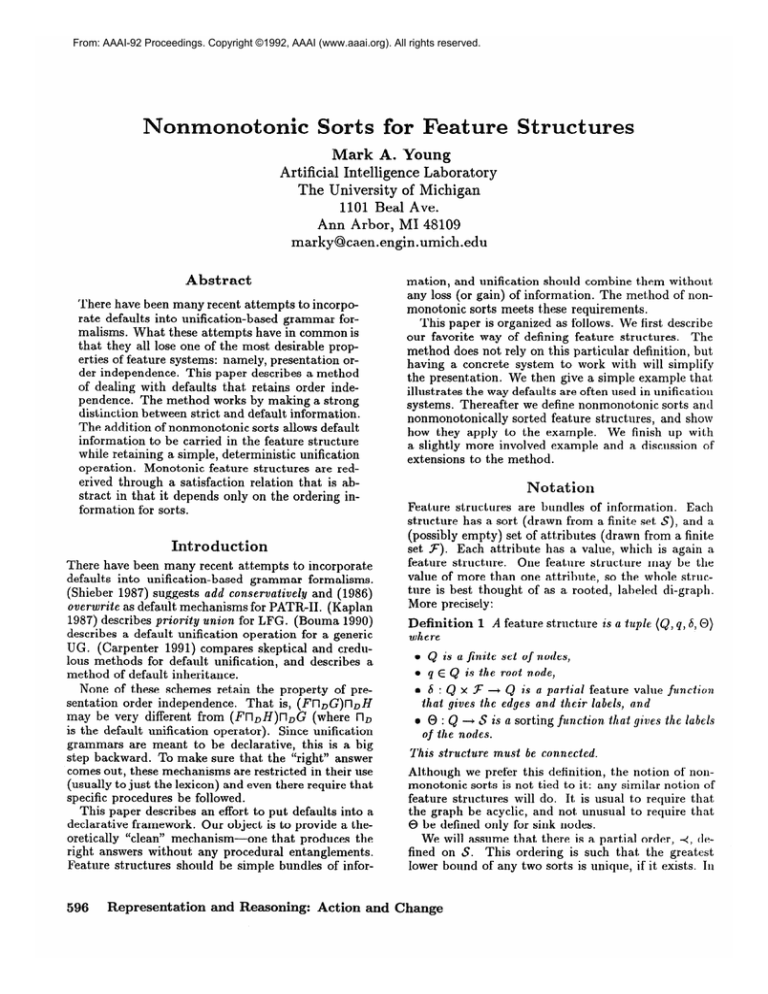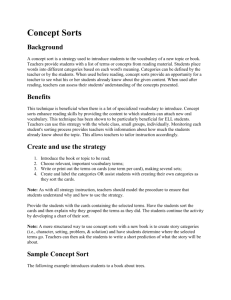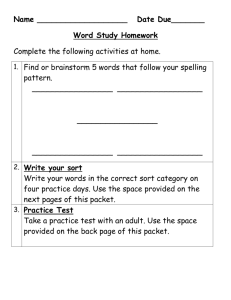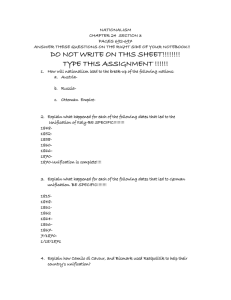
From: AAAI-92 Proceedings. Copyright ©1992, AAAI (www.aaai.org). All rights reserved.
Nonmonotonic
orts for Feature Structures
Mark A. Young
Artificial Intelligence Laboratory
The University of Michigan
1101 Beal Ave.
Ann Arbor, MI 48109
marky@caen.engin.umich.edu
Abstract
There have been many recent attempts to incorporate defaults into unification-based
grammar formalisms. What these attempts have in common is
that they all lose one of the most desirable properties of feature systems: namely, presentation
order independence.
This paper describes a method
of dealing with defaults that retains order independence.
The method works by making a strong
distinction
between strict and default information.
The addition of nonmonotonic
sorts allows default
information
to be carried in the feature structure
while retaining
a simple, deterministic
unification
operation.
Monotonic feature structures
are rederived through a satisfaction
relation that is abstract in that it depends only on the ordering information for sorts.
Introduction
There have been many recent attempts
to incorporate
defaults into unification-based
grammar
formalisms.
(Shieber 1987) suggests add conservatively
and (1986)
overwrite as default mechanisms for PATR-II.
(Kaplan
1987) describes priority union for LFG. (Bouma 1990)
describes a default unification
operation
for a generic
UG. (Carpenter
1991) compares skeptical and credulous methods for default unification,
and describes a
method of default inheritance.
None of these schemes retain the property of presentation
order independence.
That is, (Ffl,G)fl,H
may be very different from (Fn,H)n,G
(where fl,
is the default unification
operator).
Since unification
grammars
are meant to be declarative,
this is a big
step backward.
To make sure that the “right” answer
comes out, these mechanisms
are restricted in their use
(usually to just the lexicon) and even there require that
specific procedures be followed.
This paper describes an effort to put defaults into a
declarative framework.
Our object is to provide a theoretically
“clean” mechanism-one
that produces the
right answers without any procedural
entanglements.
Feature structures
should be simple bundles of infor-
596
Representation
and Reasoning:
mation, and unification
should combine them without
any loss (or gain) of information.
The method of nonmonotonic sorts meets these requirements.
This paper is organized as follows. We first describe
The
our favorite way of defining feature structures.
method does not rely on this particular
definition, but
having a concrete system to work with will simplify
the presentation.
We then give a simple example that,
illustrates the way defaults are often used in unification
systems. Thereafter we define nonmonotonic
sorts and
nonmonotonically
sorted feature structures,
and show
how they apply to the example.
We finish up with
a slightly more involved example and a discussion of
extensions to the method.
Notation
Feature structures
are bundles of information.
Each
structure
has a sort (drawn from a finite set, S), and a
(possibly empty) set of attributes
(drawn from a finite
set F). Each attribute
has a value, which is again a
feature structure.
One feature structure
may be the
value of more than one attribute,
so the whole structure is best thought of as a rooted, labeled di-graph.
More precisely:
Definition 1 A feature
is u tuple
structure
(Q,
q, S, 0)
where
a
Q
l
q E
0
is
6 : Q
Q
a finite
set
is
root
the
x F
+
that gives th.e
of
nodes,
n.ode,
Q zs a partial
edges
and their
a 0 : Q -+ S is a sorting
of the
feature
function
value function
labels, a.n,d
that
gives
the
lube/s
nodes.
This structure
must be connected.
Although we prefer this definition,
the notion of nonmonotonic sorts is not tied to it: any similar notion of
feature structures
will do. It is usual to require that
the graph be acyclic, and not, unusual to require that
0 be defined only for sink nodes.
We will assume that there is a partial order, 4, defined on S. This ordering is such that the greatest
lower bound of any two sorts is unique, if it exists. In
Action and Change
VERB template
VERB template
<past tense suffix> defmdt +te
<past participle prefix> a’sagef
<past participle suffix> default +t
<past tense suffix> isa +te
<past participle prefix> isa ge+
<past participle suffix> isa +t
spiel lex VERB
spiel lex VERB
MIXED-VERB template VERB
<past participle suffix> isn +en
MIXED-VERB template VERB
<past participle suffix> isa +en
mahl lex MIXED-VERB
mahl lex MIXED-VERB
STRONG-VERB template MIXED-VERB
<past tense suffix> dsa 0
STRONG-VERB template MIXED-VERB
<past tense suffix> asa 0
zwing lex STRONG-VERB
<past tense stem> isa zwang
<past participle stem> isa zwung
zwing lex STRONG-VERB
<past tense stem> ksa zwang
<past participle stem> 4sa zwung
Figure
1: Example
Lexicon
Entries
(where
other words, (S U {I}, -t) is a meet-semilattice
L represents
inconsistency
or failure).
This allows us
to define the most general unifier of two sorts as their
greatest lower bound, which write as a&b.
We also
assume that there is a most general sort, T, called top.
The structure
(S, 4) is called the sort hierarchy.
The main operation carried out on feature structures
is unification.
We write FnG for the most general unifier of F and G. Since we are working with sorted
feature structures,
we will require a method of sorted
unification
(Walther
1988). Note that the restriction
on the sort hierarchy will ensure that most general unifiers are unique if they exist at all.
Defaults
and the Lexicon
Defaults most commonly appear in the lexicon of natural language systems. The formation of verb tenses is
particularly
suited for the use of defaults, and we will
be using examples of tense formation
to illustrate our
method.
We assume that our lexicon is made up of a system of templates and lexical entries. These objects are
arranged in an inheritance
hierarchy, with templates
corresponding
to non-terminals
of the grammar
and
lexical entries to terminals.
Figure 1 shows a simple hierarchy for a subset of German verbs. There are three
kinds of verbs indicated:
weak, mixed, and strong. The
VERB template holds information
about weak verbs.
It specifies that the suffix for the past tense is +te,
and that the past participle
prefix and suffix are ge+
and -/-t respectively.
The MIXED-VERB
template indicates that it inherits information
from VERB, and
that the past participle suffix for mixed verbs is +en.
The lexical entry m~uhl is an instance of the MIXEDVERB template.
It is intended that mahl will get +te
as a past tense suffix and Se-/- and +en as past participle affixes. However, if we use only strict unification,
we will find that the information
specified for muhl is
inconsistent.
In particular,
we get +en as a past par-
Figure
2: Example
Lexicon
with Defaults
ticiple suffix from MIXED-VERB,
and ft from VERB.
Since strict unification
cannot deal with this situation,
we need a form of default unification
to save us. (We
could stick to strict unification
if we simply replicatzd
the required information
in every template.
This would
not only lose meaningful
generalizations,
but woulcl
also 1ea.d to much larger lexicons.)
Current methods to deal with defaults introduce an
asymmetric
“default unification”
operation.
Systems
using these methods might start at the top of the hierarchy and work down toward the lexical entries, r-eplacing inconsistent
information
as it is found.
Or
they might start at the lexical entries and work their
way up, conserving information
by ignoring conflicts.
These conflict resolution methods are by their very nature sensitive to order of presentation.
There is very
much a notion of “what we knew before” and “what
we are being told now.” Such methods cannot hope
to provide a decla.rative way of dealing with defaults.
For that we need a whole new way of looking at the
matter.
Nonmonotonic
Sorts
To allow defaults in our feature structures,
we introduce the notion of nonmonotonic
sorts (NSs). The intuition behind a nonmonotonic
sort is that it encodes
both strict and default information,
and it keeps the
distinction
between the two kinds of information.
We
cannot be sure what sort, a NS will finally turn out to
be. That is, a NS is a description
that may be satisfied
by various sorts.
Looking back at Fig. 1, we can see that the suffixes
+te a,nd j-t are both defa.ult information.
Each is contradicted
by information
lower in the hierarchy.
The
suffixes +-en. and 0 and the prefix ge+ are, on the other
hand, strict information.
They are not contradicted
by
information
lower in the hierarchy.
We make this information
explicit in Fig. 2.
Nonmonotonic
sorts are defined in terms of the
Young
597
monotonic sorts they describe. That is, we start with
the same hierarchy
of basic sorts, (S, +), with the
same sort unification
operation,
As defined on S. A
nonmonotonic
sort occurs when we say that a feature
structure
is “strictly of this sort” and “by default of
that sort .” The intent of Fig. 2 is that the past participle suffix of mahl will be strictly -ten and only by
default -/-A Since the two are incompatible,
-ten will
overrule +t, and mahl will get the correct suffix regardless of the order templates
are scanned.
Once formed, NSs can be freely combined, leading to
NSs with multiple strict and default sorts. The strict
parts can be combined into a single sort through sort
unification.
Default parts cannot be so combined, however. This is because the two pieces of informationthat this FS is by default of sort a and that it is also
by default of sort b-are
two independent
pieces of information which may be independently
overruled. The
default parts must be kept separate, not only from the
strict parts, but also from each other. But default sorts
can be made more specific by adding the information
that they must be subsumed by the strict information.
Definition 2 A nonmonotonic
sort is a pair (f, A)
where f E S, and A C S such that for each d E A,
a’+ f.
We write N for the set of nonmonotonic
sorts.
Note that a nonmonotonic
sort can be made from
any sort f, and subset D of S. Those elements of D
that are inconsistent
with f can be discarded.
The remaining sorts can then be sort-unified
with copies of f,
discarding
duplicates.
Nonmonotonic
sort unification
uses a similar method to combine the information
from
two NSs without loss or gain.
Definition 3 The
nonmonotonic
(.!$;dA,v(fz,
sorts
A,>)
e f = fiASf2,
9 A={dAsf
nonmonotonic
(fi, Al) and
sort
unifier
of
(fi, As) (written
sort (f, A)
is th e nonmonotonic
and
IdeA&JA2A(dAsf)+f}.
The nonmonotonic
is undefined.
sort unifier
is undefined
if fiAsf2
The definition of AN allows defaults to be eliminated
in two ways (neither of which changes the information present). If a default sort is inconsistent
with new
strict information,
it is dropped (we follow the convention that if dAsf is undefined, then dAsf 4 f is false).
Also, new strict information
may be more specific than
a default sort; the redundant
default is then dropped.
Going back to our example above, the past participle suffix in VERB is of nonmonotonic
sort (T, ( -/-t}) ,
while that of MIXED-VERB
is (-/-en, 0). Their nonmonotonic
sort unifier is (-/-en, (}) since +tAs+en
is
undefined.
Theorem 1 Nonmonotonic
mutative
598
and associative
sort unification
operation.
Represent at ion and Reasoning:
is a com-
Proofi The method is defined simply in terms of sort
unification
and set union, both of which are commutative and associative.
The proof that NS unification
retains these properties
is straightforward
(though te0
dious).
Because of this, we may meaningfully
speak of the nonmonotonic
unifier of a set of nonmonotonic
sorts, and
not worry about the order that they are presented in.
We said earlier that we could not be sure what sort
a NS would turn out to be. We can, however, give
the range of possible values. First we define a weaker
notion of expZan,ation. This notion is borrowed from
Theorist (Poole et aZ. 1986). In that default reasoning
system, a belief can be explained
by showing that it
follows from what is known together with a consistent
set of hypotheses.
In our case, what is known is the
strict information,
and the possible hypotheses are the
default sorts. A set of hypotheses
is consistent, if its
sort unification
exists. Thus we have:
Definition 4 A set D is said to be a theory of a NS
(f, A) if D C A and (l\,D)
is de$n,ed. A theory D
explains a sort t if t = fAs(l\,D).
The reason for including
f in the definition
of explanation is that D may be empty (in which case we take
AsD to be T). We will say that a NS, n, explains a
sort, t, if there is a theory of n which explains t. The
only sort explained by (-ten., {}) is +en itself. On the
other hand, (T, { +t}) explains both T and +t.
Theorem 2 For each sort t that (f, A) explains, there
is a unique maximal
theory fort, equal to the union of
all theories for t.
Proof.- Given any two theories for t, say D1 and Dz,
t is the greatest
lower bound of {f} U II1 as well as
the greatest, lower bound of {f) U Dz. Thus t is t,he
greatest lower bound of {f } U D1 U 02. Thus D1 U D:! is
a theory for t. This is easily extended to finitely many
0
theories.
This allows us to associate a unique “best” theory with
each expla,ined sort.
The set of sorts that (f, A) explains is in general too
large for our purposes.
The idea of a default is that,
it is true unless proven false. Therefore,
we want to
restrict ourselves to sorts that include as many defaults
as possible.
Definition 5 A sort t is a solution for a NS n =
(f,A) i,f i t is
.. ez:
e pl ained by a m.aximal theory of n. Th(lt
is,
a M E A and t = fAs(&ikf),
edtfi;;il
D c
A such that M c
D,
(&D)
is not
, .
The solutions for (-/-en, (1) and (T, { +t}) are +en and
+t respectively.
There may be multiple solutions
to
a single NS, because default sorts can be individually
consistent with the strict, sort while being inconsistent
with each other. We say that a sort satisfies a NS n if
Act ion and Change
s is subsumed by some solution for n. Thus
for n is also a most general satisfier for n.
a
solution
Theorem 3 The solutions
of a NS n are the informationally maximal sorts explained by n. That is, if t
is a solution of n then there is no s 4 t such that n
explains s.
Proof: Let t be a solution for n = (f, A) and let T be
the maximal theory for t. Assume there is an s 4 t
explained by n and let D be some theory of n that
explains s. We then have:
fAsoLwm)
tense suffix> isa 8
<past participle suffix> h
<past
+en
beat lex STRONG
forbid lex DDOUBLE,STRONG
<past tense stem> e’saforbade
sAst
Structures
with Defaults
function,
52 : Q 3
N.
Unification
of NSFSs is carried out as for monotonic
FSs, but with nonmonotonic
sort unification
replacing
sort unification.
Since nonmonotonic
sort unification
is order-independent,
nonmonotonic
unification
is also
free of ordering effects.
The notions of explanation,
and solution are easily
extended to NSFSs. A node’s sort information
is local to it, and so we only need to look at each node
separately.
Definition 7 A NSFS,
F = (Q, qo, S, Q), explains
a
C, if and only if
e C = (Q,Qo, 6, @), and
explains O(q).
C is a solution for F
each q E Q.
STRONG template VERB
(fAs(AsD>>As(fAs(AsT))
nonmonotonic-sorting
e k/q E &.0(q)
nod lex DDOUBLE
=
=
Definition 6 A nonmonotonically
sorted
feature
structure
is a tuple (Q, q, 6, R) where Q, q, and 6
are defined as for feature
structures,
and R is a
structure,
DDOUBLE template VERB
<past tense suffix> default +d+
<past participle suffix> default +d+
f ~suLDMs(AsT)
We have now said just about everything we want to say
about nonmonotonic
sorts. Nonmonotonically
sorted
feature structures
(NSFSs) are easy to define, given
what has gone before. You can think of a NSFS as a
FS that is decorated with NSs instead of sorts. While
this view makes them easier to understand,
it should
be remembered
that they are more properly thought
of as descriptions
of feature structures.
In particular,
each NSFS stands for its set of solutions.
feature
call lex VERB
=
Obviously T c (D U T) (equality would require s = t
as well), so T fails to be a maximal theory of n. That
0
means t is not a solution:
a contradiction.
Feature
VERB template
<past tense suffix> deja& +ed
<past participle suffix> default +ed
if O(q) is a solution for $2(q) for
A feature structure
is said to satisfy a nonmonotonically sorted feature structure,
F, if and only if it is
subsumed by some solution for F.
Figure
3: Multiple
Defaults
Lexicon
Given that we know how to find the solution(s)
for
a NSFS, it remains only to determine
under what circumstances
it is appropriate
to do so. Since the purpose of the lexicon is to associate feature structures
with lexical entries, it is clear that it is appropriate
to
take solutions at that level. Taking the solution at any
other level would be an error. Nothing inherits from a
lexical entry, so the information
in a lexical entry ca.nnot be overruled.
Defaults appearing in templates,
on
the other hand, are likely to be overruled by information in lower templates
and lexical entries.
Given these definitions, we can work out the full feature structures for the verbs given in Fig. 2. The lexical
a strict value +e?L
entry mahl gets from MIXED-VERB
for the past participle suffix. From the VER.B template
it inherits a strict, PP prefix, and a default PT suffix.
The default PP suffix +t from VERB is incompatible
with the strict PP suffix in MIXED-VERB,
and so is
dropped.
There is only one solution to the resulting
description,
one with PT m.a,hlte and PP gemahlen.
Similarly, we get spielte and gespielt for the VERB
spiel, and zwang and gerwungen
for the STRONGVERB zwing .
Structures
with Multiple
Sorts
The example given above was very simple, involving
as it did a very flat sort structure.
Fig. 3 uses a set of
sorts with some more order. In particular,
it represents
a doubled final d with the +d+ sort. (The example is
only given to illustrate the method. It is not meant to
represent an adequate linguistic analysis.)
This combines with the +ed and +en sorts to make the +ded
and +den sorts. The Q)sort is incompatible
with any
other sort, and +ed is incompatible
with +en.
(See
Fig. 4.)
The analysis for call is quite simple. It is a solution
of the verb template,
and so takes the default endings
to yield culled and culled. The value for beat is the soYoung
599
Conclusion
+den
Figure
+ded
4: Simple
Sort Hierarchy
lution to the STRONG template.
Here the strict values
for the suffixes overrule the defaults from VERB, and
so the solution can be read directly from the template:
beat and beaten.
The analysis
for nod is not very complicated.
The past tense suffix has two default values,
+ed
from VERB, and +d+ from DDOUBLE,
giving NS
(T, { -f-ed,+d+}).
These are compatible,
so both can
be used in the solution,
yielding a +ded sufSx (nodded).
The same reasoning
exactly gives the (same)
past participle,
nodded.
The analysis for forbid is a little more complicated.
Consider the past participle.
The suffix here inherits
three values: (T, (+ed}) from VERB, (T, { +d+}) from
DDOUBLE,
and (+ en, (}) from STRONG.
The +en
is incompatible
with the +ed, and so overrules it. The
+d+ is still consistent
with the +en, and so is retained.
The resulting
NS is (-/-en, (+den})
(remembering
to
unify +d+ with a copy of $-en). The solution has +den
as a suffix: forbidden.
For the past tense, however, the
0 suffix overrules both the +ed and +d+, meaning that
we get (0,{}):
forbade.
The analysis of forbid shows that nonmonotonic
sorts can handle in a straightforward
way what other
systems require special methods for. Systems that conserve information
have to inherit from STRONG before
DDOUBLE so that the empty suffix for past tenses appears before the +d+ (otherwise it would get *forbaded
as the past tense). Since there is no a priori reason to
use this order, the system must give some way for the
user to order templates
other than simple inheritance
order.
Systems that use replacement
are even worse off for
this example.
These systems must start with VERB
in order to correctly overrule the -/-ed suffixes. Given
that, the information
from STRONG must be added
before that from DDOUBLE:
otherwise the fed and
+d+ sorts would b e combined to form -/-ded, and then
+en would overwrite them both (yielding
*forbiden).
Conversely, the system must add the information
from
bef ore that from STRONG,
lest the +d+
DDOUBLE
overwrite the Q)(giving *forbaded). To solve this problem, the system must break one of DDOUBLE
or
STRONG into two parts, or must augment the default,
unification
operator somehow.
600
Representation
and Reasoning:
In an effort to put defaults in a declarative framework,
we have developed the concept of nonmonotonic
sorts.
Nonmonotonic
sorts make a distinction
between strict
and default information.
Maintaining
this distinction
allows us to define a simple unification
operation
that
respects the information
encoded in the nonmonotonic
sorts. This operation allows us to use a single structure
to keep track of multiple possible solutions in a completely deterministic
way. Since the method is declarative, multiple inheritance
with defaults can be carried
out without
regard to the order that information
is
presented.
The method
as described
above only deals with
The method can easily be exatomic information.
tended to deal with path information
(using a node
instead of a sort). To say that two paths are by default equal means that the nodes at the ends of those
paths are by default the same structure
(as opposed to
other systems, where it, usually means that they have
similar information
by default).
We are currently
investigating
the properties
of such a system, including
the question of how such unification
tests would best
be carried out (adding default equations leads to nonlocal effects in the NSFS).
We have already developed a version of the method
that uses priorities on defaults sorts to choose between
multiple solutions.
The most natural system of priorities would mirror the structure
of the lexicon.
This
extension
allows for defaults appearing
at lower levels of the lexicon to overrule those appearing
at, more
general levels.
We are also investigating
the effect of typing inforsorts. Such
mation (Carpenter
1992) on nonmonotonic
inform&on
allows a limited form of inference to be carried out, within a FS. As with default equations,
this
leads to non-local effects in the FS. In both cases, a
solution FS may not be made up entirely of solution
sorts, but will consist entirely of explained sorts.
References
Bouma, Gosse 1990. Defaults in unification
grammar.
In Proceedings of the 1990 Conference
of the Association
for Computation.al
Linguistics.
165-172.
deCarpenter,
Bob 1991. Skeptical and credulous
fault unification
with applications
to templates
and
inheritance.
In Proceedhgs
of Acquilex Workshop ou
Defaults
Ca.rpenter,
Structures.
and the Lexicon.
The Logic of Typed Feature
Bob 1992.
Cambridge
IJniversity Press. To appear.
Kaplan, Ronald 1987. Three seductions
of computationa.1 linguistics.
In Lin.guistic Theory and Computer
Applications. Academic Press, London.
149-188.
Poole, David; Goebel, Randy; and Aleliunas,
Romas
1986. Theorist:
A logical reasoning system for defaults and diagnosis. Reseazch Report CS-86-06, University of Waterloo.
Action and Change
Stuart 1986. An Introduction to UnificationBased Approaches
to Grammar,
volume 4 of CSLI
Lecture Notes. University
of Chicago Press, Chicago.
Shieber,
Shieber, Stuart
from linguistic
Computer
1987. Separating
linguistic
analyses
In Linguistic
Theory and
theories.
IApplications. Academic Press, London.
36.
Walther,
Journal
Christoph
1988.
Many-sorted
unification.
of the ACM 35(1):1-17.
Young
601





